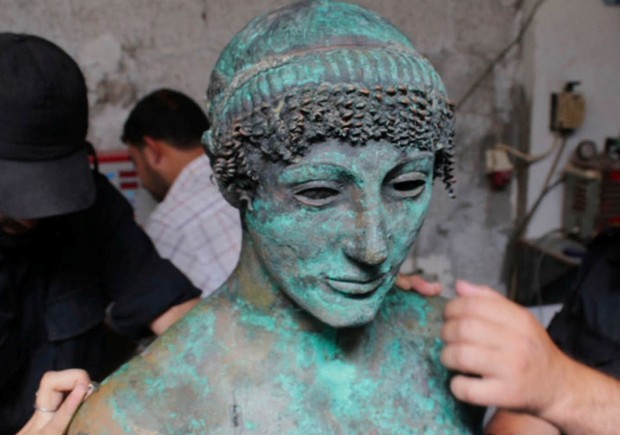Apollo of Gaza. Gaza, 5th century BCE
A rare bronze sculpture of the
Ancient Greek god Apollo was found in the Gaza Strip in 2013. It was put for
sale on eBay, and subsequently withdrawn from sale and seized by police thanks
to the publication of the story along with photographs by the Italian
journalist Fabio Scuto on La Repubblica.
The statue was claimed to have
been recovered from the sea in August 2013 by Joudat Ghrab, a local Palestinian
fisherman. Ghrab said that he saw the statue lying in shallow waters near the
Gaza border with Egypt, and initially thought the statue was a badly burnt
body. It took four hours to get the statue ashore. The statue was later put for
sale on the internet auction site eBay for $500,000 by members of Ghrab’s
family. The sale price is believed to be significantly below its true value.
Police appointed by Hamas, the rulers of the Gaza Strip, subsequently seized
the statue and are investigating its provenance.
The statue has not been examined
by archaeologists, but a Reuters report published in The Guardian attests to “a
few blurred photographs of the intact deity, who is laid out incongruously on a
blanket emblazoned with Smurfs”. The evidence dates the statue to between the
5th century BCE and the 1st century BCE. The statue depicts Apollo with curly
hair and one eye possibly inlaid with a blue stone iris, standing upright with
an outstretched arm, and with his palm held up.
Historians have suggested that
the statue was found on land rather than at sea owing to its apparent good
preservation, without signs of metal disfigurement or barnacles. Noting the
green patina, Gaza archaeologist Fadel al-Utol said: “If it had spent time
underwater, the bronze would be blackened.” The obscure location of the
statue’s discovery could be used to avoid ownership arguments.



